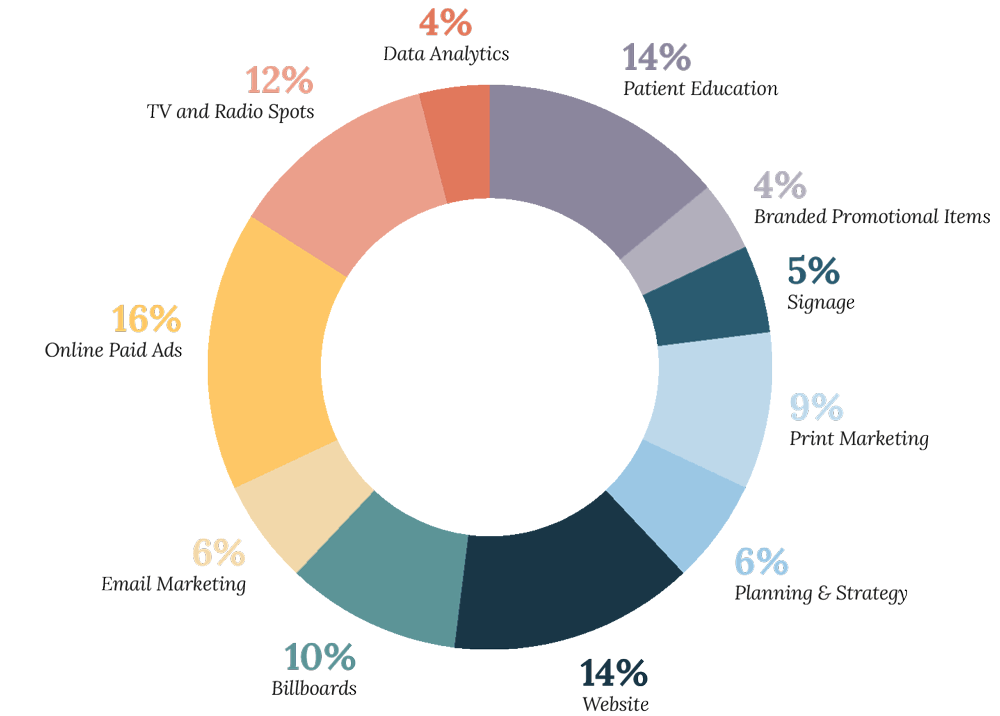It’s that time of the year again. Kids are heading back to school, and COOs and CMOs at hospitals and health systems across the country are making plans for 2024 that not only sustain but fuel patient growth. Central to the success of all those projection work is the creation of a strategic healthcare marketing budget.
After a year of financial ups and downs in 2023, thinking about your healthcare marketing needs in 2024 may seem especially daunting, especially if you know that marketing funds will be squeezed. The good news is you’re not alone. Just about everyone is having to do more with less in this post-COVID era of non-stop disruption.
On top of all that, old solutions won’t cut it. What works (and what doesn’t) continues to evolve rapidly. Plus, there are more ways than ever to reach your target audiences, staffing continues to pose a very real challenge, and new technologies (like AI tools for marketing) are changing the way the game is played.
Read on for tips on how to maximize your 2024 healthcare marketing budget to ensure you spend your patient marketing funds wisely and continue to grow during uncertain times.
Investing in healthcare marketing
Nobody can overstate the importance of marketing in healthcare. It uses measurable data to grow your ROI and practice.
Healthcare took a hit during the pandemic. There were sharp drops in revenue and jobs in the first year alone. The right healthcare marketing strategies can help many organizations bounce back.
How? They had the data to back it up. They could track their performance, spot improvement, and target high-quality leads. They also built better patient-provider relationships.
You can’t do this effectively without a sound healthcare marketing budget. Here’s a high-level look at key parts of the process.
Research your audience
Knowing your patients and what they need (as well as the unique factors in your market at a macro level) isn’t just a good idea. It’s a necessity. These can all profoundly impact your strategic decisions.
And here’s a twist: you can employ healthcare informatics for a deeper level of market analysis. This unconventional approach leverages technology to predict trends, enabling your organization to always stay one step ahead.
Identify your goals
You can’t hit a target if you don’t know what it is. Your marketing goals need to be S-M-A-R-T: Specific, Measurable, Achievable, Relevant, and Time-bound.
Then, ensure these goals are in sync with the broader vision of your healthcare organization.
You may also consider adopting the Objectives and Key Results (OKRs) framework. While unconventional for healthcare, this goal-setting system can provide a clear direction and measurable outcomes on a large scale.

Draft your marketing budget
Crafting a marketing budget that complements your organizational goals and market needs is crucial. From digital advertising and SEO to content marketing and PR, resources should be allocated thoughtfully.
A novel approach to consider is Zero-Based Budgeting (ZBB). With ZBB, every expense must be justified in each new period, providing a detailed view of where your money’s going and enabling strategic decision-making.
Identify and reduce wasteful expenditures
Every penny counts when it comes to marketing budgets. Identifying the sources of wasteful spending can result in significant savings. Tools that provide real-time tracking and data analysis can help you spot unnecessary outflows.
In a departure from traditional methods, you might find it useful to incorporate lean management principles into your operations. This focuses on maximizing customer value while minimizing waste—a win-win!
Track and monitor results
Even the best-laid plans need monitoring and adjustments. Regular reviews of your marketing budget will ensure you’re on track. Predictive analytics can be your secret weapon here. By predicting future trends, it can help you make data-driven budget adjustments.
Today, more than ever before, ROI and efficiency matter. Look for ways to unleash cost-effective strategies—such as organic social media, SEO, and content marketing—which can yield significant returns. Pay attention to which are the best at helping you convert and build brand awareness, and adjust your strategy accordingly.
Don’t forget to focus on patient satisfaction
Your budget can be a powerful tool in enhancing patient experiences. From follow-ups to personalized patient interactions, your marketing strategies can significantly boost patient loyalty and satisfaction.
How about adding a dash of fun with gamification? Implementing game design elements in non-game contexts, like a patient portal, can boost engagement and improve the patient experience.
5 questions to consider while making budget plans
Once you’re ready to invest in patient marketing, you’ll need to know what to focus on in your budget.
Below is a list of questions to help you navigate your medical marketing needs.
How much marketing is your practice doing, and how much are you spending?
Technically, you don’t need a marketing strategy to promote your organization. You might have already paid for a website, business cards, or swag, which are all forms of marketing.
What are your patients saying about their care?
Ask your current patients to take surveys on how they found your practice and if they’re satisfied. They are an excellent resource for informing what works, and what doesn’t, with your current marketing strategy.
Pay close attention to what they don’t say, too.
What are your business goals, and what does your timeline look like?
This question is critical, as your answer will be the heart of your marketing efforts.
Think about how happy you and your doctors are with their patient count. Do they want more patients? Should the focus be on higher patient retention? Should you expand your practice?
How much value do new patients bring to your organization?
The answer to this question may shift how you set goals for your budget. Patient value changes as patient referrals and patient care costs fluctuate. It provides a baseline for other budgets, too.
As you estimate, create persona profiles of your patient demographic and their treatments. Doing so will provide great insight for target marketing in healthcare.
What makes up this value? It is typically based on the average number of patient visits per year, how much they pay each time they visit, and the average cost to care for them.
How much are your competitors spending?
While necessary to know, this one won’t be the easiest to figure out. A reputable healthcare marketing agency will help you develop a reasonable estimate.
New marketing ideas for acquiring patients
So, how about exploring virtual reality (VR) and augmented reality (AR) for interactive marketing efforts? As outlandish as it might sound, immersive tech can offer unique, engaging experiences, giving you an edge in patient acquisition.
It’s a competitive world out there, and attracting new patients demands strategic budget allocation. Staying ahead of the curve can be the difference between attracting new patients and being left behind.
- Tours
- Wellness programs
- Patient education
Tours
Give prospective patients to tour your hospital or facility using a VR headset or their smartphones. Show off patient rooms and operating theaters to recreational spaces. This will familiarize them with your space and provide a glimpse at the quality of care they can expect. This can help build trust and influence their decision-making.
Wellness programs
VR and AR can take these programs to the next level. Consider offering virtual yoga classes or mindfulness sessions through a virtual platform. This can help your organization reach out to a wider audience, beyond your immediate locality, and attract potential patients who are interested in holistic healthcare.
Patient education
VR and AR can be harnessed to educate potential patients about complex medical conditions and treatments in an engaging, easy-to-understand format.
For instance, an AR app could illustrate how a specific drug works in the body or how a medical condition progresses over time. Such informative, interactive content can position your organization as a leader in patient education, potentially attracting patients who value understanding their healthcare journey.
FAQs about healthcare marketing budgets
Continue reading to find answers to common questions about healthcare marketing budgets.
What is a reasonable budget for healthcare marketing?
Determining a healthcare marketing budget depends on several factors. Some include your marketing goals, annual profit, and organization size.
Before the pandemic, the average rate for marketing budgets was about 11% (pdf) of a company’s revenue. Once the pandemic began, rates dropped to roughly 6%–9% in 2021 and 2022.
How much do hospitals spend on marketing?
Hospital marketing averages $5.6 million per year.
How much does the healthcare industry spend on digital advertising?
Healthcare marketers spent (in digital advertising costs ) around $15.84 billion in 2022 and the estimate for costs in 2024 is higher, at about $20 billion.
Grow with the right healthcare marketing budget
Every day, there are new and innovative ways to advertise your organization. The right marketing agency can help you make the right choices and stay within your budget.
When to partner with a healthcare marketing agency
If you lack an internal marketing team or feel it’s time to work with an agency, TBH Creative is here to help. We’re an award-winning, full-service healthcare marketing agency.
We know how to maximize your budget and exceed your marketing goals. Contact our team to learn how our experts can bring your vision to reality.

